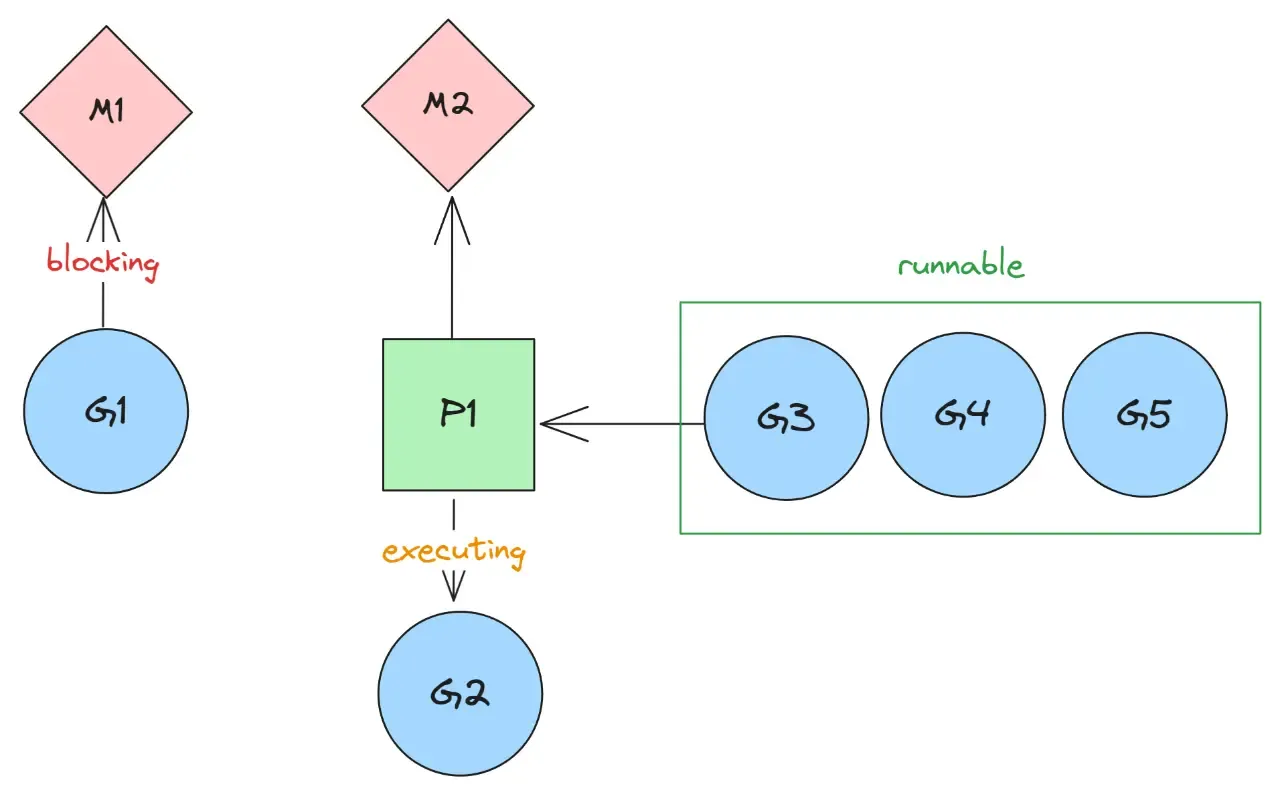
Goroutines
/ 5 min read
Table of Contents
A goroutine is a lightweight thread of execution managed by the Go runtime. To start a new goroutine we use the go keyword
go f(x, y, z)The evaluation of f, x, y, and z happens in the current goroutine and the execution of f happens in the new goroutine.
Goroutines run in the same address space, so access to shared memory must be synchronized. The sync package provides useful primitives, although you won’t need them much in Go as there are other primitives like channels.
When to use?
With goroutine, we can make asynchronous network IO and continue the program without the need to wait for the response to come back. Obviously, network IO is just one of the many examples. We can do parallel processing like a mini map reduce and fully utilize each CPU core we have on our modern days machine.
Architecture
goroutine is not a os/kernel thread. It is an abstraction of a thread, more commonly known as application thread. It is Go runtime’s job to manage how many OS threads to create and how goroutines are mapped to and executed on OS threads.
Go Runtime Components
There are three main components involved in the execution of a goroutine i.e. the goroutine, an abstract logical processor and the machine.

- Goroutine: Each goroutine is described by a G struct. The struct keeps track of various runtime information, like stack trace and status.
- Logical Processor: P stands for Logical Processor. It’s an abstract resource or context. We usually call P a context that is mapped to a M to run Gs.
- Machine: The struct M stands for machine, which maps to an OS thread which can execute a G or goroutine.
Entity Interaction
When a Go program starts, it is given a logical processor P for every virtual core. Every P is assigned an OS thread M. Every Go program is also given an initial G which is the path of execution for a Go program. OS threads are context-switched on and off a core, goroutines are context-switched on and off a M.

P is responsible for scheduling all runnable Gs on M. If and when an executing G makes a blocking call, P moves onto a different M while G blocks the current M.
Controlling Parallelism
We can set the maximum number of goroutines executing in parallel by limiting the number of P.
package main
import ("fmt""runtime")
func main() { fmt.Println(runtime.GOMAXPROCS(1))}This limits the maximum number of P to 1 but that won’t limit the program to not spawn more than 1 M (OS Threads) in case of blocking call as stated above.
Thread Synchronization
Don’t communicate by sharing memory; share memory by communicating
This is the moto which go lang has popularized, in which we don’t give threads access to shared memory but instead share messages/data by communicating with each other.
Channels
Channels are a typed thread safe conduit through which you can send and receive values with the channel operator, <-.
ch <- v // Send v to channel ch.v := <-ch // Receive from ch, and // assign value to v.(The data flows in the direction of the arrow.)

Like maps and slices, channels must be created before use:
ch := make(chan int)By default, sends and receives block until the other side is ready. This allows goroutines to synchronize without explicit locks or condition variables.
We can also use buffered channels which won’t block on every operation but instead only on the absence of data.
Note: Channels aren’t like files; you don’t usually need to close them. Closing is only necessary when the receiver must be told there are no more values coming, such as to terminate a range loop.
Select Statement
The select statement lets a goroutine wait on multiple communication operations.
A select blocks until one of its cases can run, then it executes that case
select { case c <- x: x, y = y, x+y case <-quit: fmt.Println("quit") return}Shared Data
Go’s standard library provides mutual exclusion with sync.Mutex and its two methods:
LockUnlock
We can define a block of code to be executed in mutual exclusion by surrounding it with a call to Lock and Unlock.
c.mu.Lock()// Lock so only one goroutine at a time can access the map c.v.defer c.mu.Unlock()return c.v[key]Data Race
It’s important to use patterns like channels and mutex locks to prevent data races otherwise go has a data race detector which will panic at runtime.
When the race detector finds a data race in the program, it prints a report. The report contains stack traces for conflicting accesses, as well as stacks where the involved goroutines were created.
WARNING: DATA RACERead by goroutine 185:[[]] net.(*conn).Write() src/net/net.go:129 +0x101
Previous write by goroutine 184: net.setWriteDeadline()
Goroutine 185 (running) created at: net.func·061() src/net/timeout_test.go:609 +0x288
Goroutine 184 (running) created at: net.TestProlongTimeout() src/net/timeout_test.go:618 +0x298
Thanks for reading please share your reviews on twitter with me @1108King and if you found the article useful do share if for visibility.